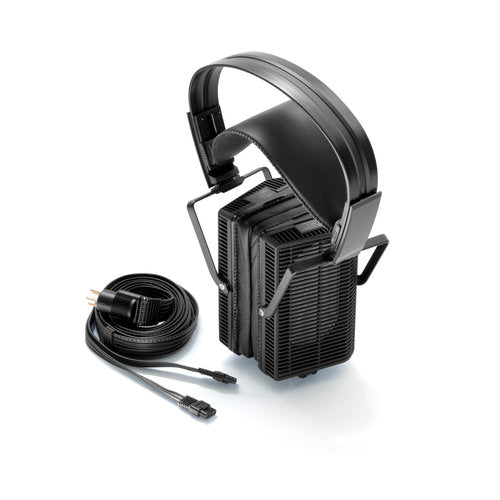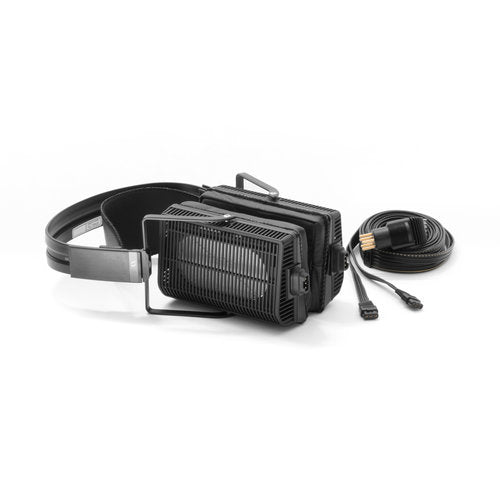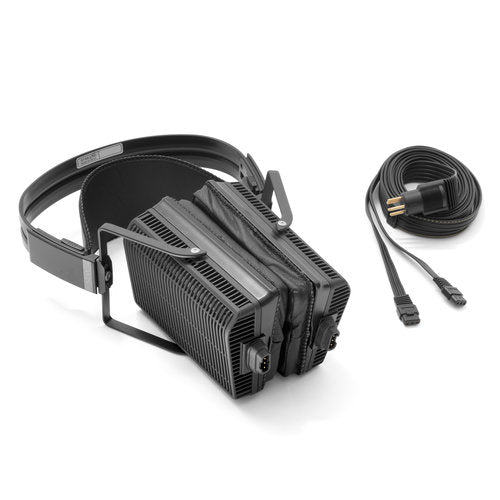Stax is a legend in the personal audio community for their continued pursuit to perfecting electrostatic headphones. They have been around for quite some time with multiple different iterations of the current Lambda series. I actually was lucky enough to own some of their original designs (SR-Lambda Signature and SR-Lambda Professional). What their designs lacked in premium finishes they more than made up for in top tier levels of resolution and speed.
Build
Many familiar with the Stax lineup will be familiar with the iconic “plastic rectangle.” It has a certain appeal and nostalgia factor for me at least. I genuinely love how they look. Being able to compare directly to their older models, it’s easy to see the improvements they made over the years. While still made of plastic, the yoke and headband feel significantly sturdier. It seems to be the same headband as that of the 009. Despite those who pick apart the design, they feel decently sturdy in the hand and on the head.
The one thing that is a huge benefit of the plastic build is reducing the overall weight of the unit. They are incredibly lightweight and easy to forget about while wearing them. The suspension strap feels like faux leather and further helps distribute weight for comfort. Another big upgrade from some of the prior models is the addition of the leather earpads. They are quite soft and add to the overall comfort.
The newest addition with the MK2 version is the addition of the detachable cable which is a huge product longevity item. Breaking a cable previously meant the whole headphone had to go back in for repair. With the detachable cable, you can now simply buy a new one should there be an issue.
Sound
Theres one thing Stax seems to have improved on as of late, and that’s making their headphones sound more organic. Especially seen in their latest flagship offering the X9000, but also seems to have trickled a bit into the lower ranges. The L700 MK2 still retains many of the unique sound qualities of past electrostatic headphones but has a few noticeable changes that improve the sound overall.
One of the main things talked about with electrostatic headphones is the lack of bass. What I have found is this is usually surrounding the impact and pressure of low end with something like a dynamic driver. While I can agree they don’t present low end with that same force and tactility, what you get instead is punchy, fast low end. The low end on the L700 MK2 extends very well with only a slight roll-off below 40 Hz. Bass is presented with good textural information and is incredibly fast which is a really unique presentation compared to other styles of headphones.
The midrange has probably been one of the most striking things for me since first getting these headphones in. It strays away a bit from the more neutral tuning of Stax in the past but really makes these headphones shine. Most Stax in the past had a small peak starting at around 1kHz to 2 kHz. The new lambdas have a bit larger peak centering around 1.5 kHz which is probably what gives the midrange a bit more warmth. Vocals are incredibly vivid and presented with more weight than previous models. While they do offer a bit more coloration than previous models, they still present recordings as very natural sounding.
The treble is where I think Stax has probably changed the most over previous models, and one thing that I tribute this to their new more organic sound. The old model Stax seemed to over emphasize the treble region. On certain recordings it sounds fantastic. It pushes forward details they may be lost otherwise. However, the drawback to this is it can make a lot of music sound a bit plasticky and harsh. The new model Lambdas seem to have reeled this in a bit and kept it incredibly smooth while still retaining all of their natural resolving capabilities. What results from this is a much more balanced and natural sound signature.
The technicalities are what really set these headphones apart. Every detail you could want is presented in spades. They easily out resolve all headphones in their price class and beyond. It really is something quite special to hear.
The soundstage overall is decent. Its not incredibly wide but is presented with nice air that gives a good sense of space. Imaging and separation are also very good but don’t stand out quite as much as their general resolving capabilities. Instruments are easily placed but can be a bit less defined overall due to the airy nature of the soundstage.
STAX L700 MkII vs Hifiman Arya Stealth
The Arya for me is another one of those solid under $2000 performers that seems to fit the price class at least of the L700 MkII. The Arya offers a much more substantial low end. It has a lot of the added body and weight that is missing from the MkII. Hifiman headphones have been called out for some by being too hot in the treble. I usually like their tuning of this actually. I think the changes in the new line of Stax of reducing overall treble brings them more in line with the Arya. Both have a smooth presentation that borders perfectly between perfectly sharp and fatiguing. Both present great air in the treble and have good clarity and detail.
Where the L700 MkII takes over for me is in the mids and overall resolution. The MkII have a really well textured, warm mid-range that I find myself drawn towards. The mids on the Arya Stealth are much less detailed and tend towards neutral a bit more.
Overall, I think the decision between these two will come down to preference. The Arya will present notes with more body and low end presence, while the L700 MkII have a nice airy yet warm presentation that pull significantly ahead in detail.
Conclusions
The L700 Mk II can easily be end-game headphones depending on sonic preferences. They provide top class detail that rivals many flagship headphones. The midrange tuning on them is incredibly enjoyable. The new treble tuning is much smoother but still provides great air and clarity. The low end is probably where the “preference” kicks in for deciding whether these headphones are for you. While I tend to prefer tight, fast low-end, they will leave some people wanting a more full-bodied experience. Overall, these are an easy recommendation for me and will be a reference for any headphone in the under $2k price bracket.




